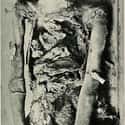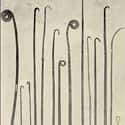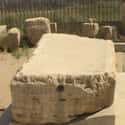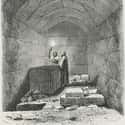-
(#7) Packing The Body Required Attention To Detail
Embalmers had to ensure bodies resembled their pre-dehydrated forms so they would be recognized in the afterlife. Once it was sufficiently dried out, the natron was removed, and it was cleaned again. In some instances, workers would collect detached fingernails, toenails, and hair that had fallen off while the body drained. Then they stuffed body cavities with sawdust, linen, and even sand, creating a lifelike form. They also included scented oils and resins.
It wasn't uncommon for the embalmers to overstuff the head and body. Queen Henuttawy was overstuffed so much that her cheeks burst. Her body was also out of proportion when it was found, although she has since been restored to a more realistic figure.
There were other concerns regarding the materials put in the body. Instructions cautioned workers to "beware lest he be turned upside down onto his abdomen or his face, for his body is filled with medicinal materials, and the gods which are within his abdomen might be displaced from their position." It was just as important to take care that nothing fell out, too.
-
(#4) There Were Several Ways To Remove Internal Organs
The process an embalmer undertook varied based on the option chosen by an individual's family. First, the brain was removed through the nose using a hook. Next, the organs in the torso were taken out using "a sharp stone of Ethiopia." They also removed the lungs, stomach, liver, and intestines, leaving the heart because they believed that was the center of a person's soul and identity. The organs were placed into canopic jars. The cavity was cleaned with palm wine and spices and was filled with myrrh and cassia before being sewn back together.
Those who desire the middle way and wish to avoid great cost they prepare [it] as follows: having filled their syringes with the oil which is got from cedar-wood, with this they forthwith fill the belly... and this they do without having either cut it open or taken out the bowels, but they inject the oil by the breech, and having stopped the drench from returning back they keep it then the appointed number of days for embalming, and on the last of the days they let the cedar oil come out from the belly, which they before put in; and it has such power that it brings out with it the bowels and interior organs of the body dissolved; and the natron dissolves the flesh, so that there is left... only the skin and the bones. When they have done this, they give back the [cadaver] at once in that condition without working upon it any more.
At the lower end of the embalming spectrum, "They cleanse out the belly with a purge and then keep the body for embalming during the 70 days, and at once after that, they give it back to the bringers to carry away."
In either of the lower-tier options, the organs were given much less care, but they were still placed into canopic jars.
-

(#10) The Ancient Egyptians Believed Everyone Deserved To Be Embalmed
Whenever any one, either of the Egyptians themselves or of strangers, is found to have been carried off by a crocodile or [succumbed to] the river itself, the people of any city by which he may have been cast up on land must embalm him and lay him out in the fairest way they can and [inter] him in a sacred [place], nor may any of his relations or friends besides touch him, but the priests of the Nile themselves handle the [body] and [place] it as that of one who was something more than man.
This indicates that the town or individuals who found a stranger were responsible for paying embalming costs. According to Diodorus, the costs may not have been too much to handle, however. Depending on the procedure, the price of the service was "one silver talent... 20 mines... [or] an altogether insignificant amount."
-

(#2) Embalming Workshops Were Adjacent To Burial Chambers
Egyptian sources refer to locations where embalming took place as "the Good House." The workshop itself was known as "the Pure Place." Historians and archaeologists have long believed embalmers erected tents or temporary structures near interment sites to do their work. This was most likely done far away from residential areas to prevent the smell from affecting the general population.
The archaeological find at the Saqqara necropolis reframes this assumption, as the workshop they uncovered was a bit more permanent than previously believed. The workshop is connected to a communal interment site where the embalmer had set up shop.
-
(#5) Water, Oil, And Salt Were At The Core Of Any Good Embalming
The process changed over time, but cleaning, drying, and purifying the body were fundamental to the procedure. Water was used to wash the body and was mixed with natron to eat away the flesh. The process was potentially harmful to the embalmers, as well - natron could be hard on the skin, eyes, and lungs.
Natron, a naturally occurring mineral salt made of sodium carbonate, was used to dehydrate the body. Once all the organs were removed from the torso, it was covered with natron and set aside for roughly 40 days. They were placed on tilted tables, so fluid would drain into awaiting containers. Evidence indicates workers used sodium chloride, or common salt, as well. During the earliest days of mummification, bodies were also covered in sand to dry naturally.
According to Diodorus Siculus, writing in the 1st century BCE, "When [embalmers] gathered for the treatment... one of them reaches with his hand through the incision into the thoracic cavity and removes everything but the kidneys and the heart. Another cleans every single piece of viscera by rinsing it with palm wine and fragrant water." Afterward, "The whole body is carefully anointed, first with cedar oil and the like."
No one knows how much of these items embalmers used; however, thanks to the find at Saqqara, archaeologists now "have oils and measuring cups - all of them are labeled... from this we can find the chemical composition of the oils and discover what they are."
-
(#1) Embalmers Provided Multi-Tiered Services
In Ancient Egypt, rulers and members of the upper classes were initially the only people who were embalmed. As it became common throughout Egyptian society, however, embalmers adjusted their practice, providing services based on the social status of the subject.
A recent archaeological find in the Saqqara necropolis in Egypt attests to this. The discovery of an embalmer's workshop with equipment and five mummies revealed "clear socioeconomic differences between the mummies in the shaft," according to Ramadan Badry Hussein, director of the Saqqara Saite Tombs Project.
The idea that not all embalming was the same, however, is nothing new. Herodotus wrote about the three kinds of embalming as far back as the 5th century BCE. When presented with a person, embalmers showed family members options for mummification:
In this occupation, certain persons employ themselves regularly and inherit this as a craft. These, whenever a [body] is conveyed to them, show to those who brought it wooden models... made like reality by painting, and the best of the ways of embalming they say is that of him whose name I think it impiety to mention when speaking of a matter of such a kind; the second which they show is less good than this and also less expensive; and the third is the least expensive of all. Having told them about this, they inquire of them in which way they desire... their friend to be prepared. Then they after they have agreed for a certain price depart out of the way.
Simply put, embalmers showed the family members three wooden examples, the first of which is believed to have resembled Osiris, and asked which model they wanted their relative to look like when they entered the afterlife.
New Random Displays Display All By Ranking
About This Tool
The whole world is curious about ancient Egyptian mummies, pharaohs, and other historical civilizations. The ancient Egyptians are known for their iconic pharaohs, pyramids, and elaborate tomb rituals, but there are few historical records of Embalmer’s hard life, who paved the way for the sacred ancient Egyptian funeral rituals and carried out a series of preservation work for dead bodies.
With the significant progress made by archaeologists in Egypt, one can speculate about the hard labor of Embalmer mummification, archaeologists excavated the ruins of ancient antiseptic workshops and found some precious historical relics. The random tool shows some ruins and relics that can speculate how a day of an ancient Egyptian embalmer like.
Our data comes from Ranker, If you want to participate in the ranking of items displayed on this page, please click here.














